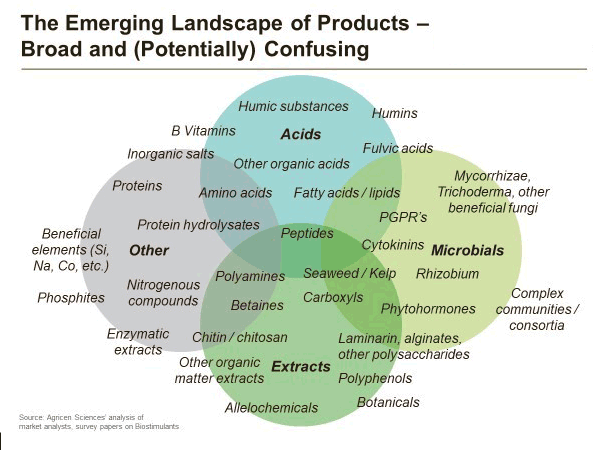What are Plant Biostimulants?
The term “plant biostimulant” has been in use since at least 1997. For more information see the USDA Farm Bill Biostimulant Report and the EPA Draft Guidance for Plant Regulator Label Claims, Including Plant Biostimulants EPA-HQ-OPP-2018-0258-0002. See also the United States Biostimulant Industry Recommended Guidelines to Support Efficacy, Composition, and Safety of Plant Biostimulant Products. at Biostimulant Efficacy Comp. and Safety Claims 0228
Yet today, there is still no single, globally accepted definition for legal, regulatory, or commercial purposes. BPIA supports the following working definition, until such time as more formal language is agreed:
Plant biostimulant means a substance, micro-organism, or mixture thereof, that, when applied to seeds, plants, the rhizosphere, soil, or other growth media, act to support a plant’s natural processes independently of the biostimulant’s nutrient content, including by improving nutrient availability, uptake or use efficiency, tolerance to abiotic stress, and consequent growth, development, quality, or yield. .1, 2
1Definition from H.R. 7752
2Biostimulants have no direct effects on controlling plant pests
Biostimulants and Sustainable Agriculture
Biostimulants are vital to meeting growing agricultural demand in a more sustainable manner. The focus of our industry is to develop and commercialize biostimulant products that are highly compatible with the most advanced farming techniques used in Integrated Crop Management (ICM), the cornerstone of sustainable agriculture.
Biostimulants contribute to sustainable agriculture by:
- Improving plant tolerance to abiotic stress on plants, including drought, extreme temperatures (cold, frost, and heat), and salinity
- Enhancing uptake and efficient use of nutrients, both applied and existing
- Improving soil health by enhancing beneficial soil microorganisms
- Enhancing crop quality through plant health and vigor
- Increasing harvestable yields
What Products are Included in “Plant Biostimulants”?
Like the general definition of plant biostimulants, the definition of the major categories of products that make up the class remains a work in progress. Efforts have been made to describe the principal categories, including scientific journal articles by Yakhin et al (2017)1, du Jardin (2015)2, Halpern et al (2015)3, Calvo et al (2014)4 and du Jardin (2012)5. As industry and regulators work toward an agreed-upon definition for plant biostimulants, we can expect to see increased clarity on the materials (or substances) that comprise the categories of biostimulant products.
1Yakhin, O.I., Lubyanov, A.A., Yakhin, I.A., and Brown, P.H. (2017). Biostimulants in Plant Science: A Global Perspective. Frontiers in Plant Science 7:2049. doi: 10.3389/fpls.2016.02049
2Du Jardin, P. (2015). Plant Biostimulants: Definition, Concept, Main Categories and Regulation. Sci. Hortic. 196, 3–14. doi: 10.1016/j.scienta.2015.09.021
3Halpern, M., Bar-Tal, A., Ofek, M., Minz, D., Muller, T., and Yermiyahu, U. (2015).The Use of Biostimulants for Enhancing Nutrient Uptake. Adv. Agron. 130, 141–174. doi: 10.1016/bs.agron.2014.10.001
4Calvo, P., Nelson, L., and Kloepper, J. W. (2014). Agricultural Uses of Plant Biostimulants. Plant Soil 383, 3–41. doi: 10.1007/s11104-014-2131-8
5Du Jardin, P. (2012). The Science of Plant Biostimulants – A Bibliographic Analysis, Ad hoc Study Report. Brussels: European Commission.
The “product landscape” in Figure 1, below, reflects the rich array of substances that are discussed in the literature. It includes the major categories discussed below, as well as other examples such as inorganic salts, other beneficial elements (beyond the traditional plant nutrients), vitamins, fatty acids, and other organic compounds.
Figure 1. Click on a Category to Learn More.

Plant Biostimulant Categories
Hidden Anchor
Acid-Based Biostimulants
Humic substances, which include humic and fulvic acids, are among the most common organic substances on earth, making up much of the organic matter in the world’s soils. Humic and fulvic acids are complex organic molecules of diverse structure and composition that form in the soil as byproducts of the decomposition and microbial metabolism of plant and animal residues. While the materials can vary quite dramatically in molecular structure and weight, humic substances have been recognized and used for decades to improve soil structure and function (e.g., chelate nutrients and improve cation exchange capacity, or CEC), enhance plant nutrition, and contribute to improved crop yield and quality. They can be applied in various ways, including direct application to the soil, foliar application, incorporation into fertilizer and other products, and through irrigation water.
Amino acid products (along with other protein-derived biostimulants, based on peptides or protein hydrolysates) can be derived from the chemical or enzymatic hydrolysis of animal, plant, or microbial protein. The protein sources are often recycled waste products of agricultural crop residues or animal processing such as collagen, epithelial tissue, crustacean shells and other materials. Recycling these otherwise waste substances into useful agricultural products is a unique environmental benefit of protein-derived biostimulants. There is strong evidence for a variety of benefits, including improved soil fertility, better plant health and vigor, enhanced crop yields and quality, and improved stress tolerance.
Hidden Anchor
Seaweed and Plant Extracts
The use of seaweed in agriculture dates to ancient times, when it was often used to improve fertility by augmenting soil organic content. Seaweed extracts, also referred to as kelp or sea kelp extracts, have been used in modern agriculture as more concentrated means to deliver benefits to soils and plants. They have been shown to improve soil properties (to improve soil structure, water retention, and aeration), as well as helping to fix or chelate nutrients and improve CEC. Seaweed extracts have also been shown to aid in the functioning of beneficial soil microorganisms, and to improve the provisioning, uptake, and utilization of plant nutrients. An impressive body of research is aimed at understanding how complex extracts and many of the constituent compounds derived from them can stimulate, elicit, or augment the healthy growth of beneficial plants. Improved stress tolerance effects have also been broadly reported.
Plant extracts (or “botanicals”) are perhaps less well studied, but represent a fast growing category of biostimulant materials. The use of allelochemicals — active plant compounds that can be extracted and concentrated — is an especially active area of both industry and academic investigation.
Hidden Anchor
Microbial Biostimulants
Beneficial fungi and bacteria represent the core of the focus within the smaller but rapidly growing category of microbial biostimulants. A wide variety of microbial products are sold as biofertilizers, plant inoculants (to aid primarily in nutrient processing), soil amendments, and other beneficial additives. Microbial products can include “pure strain” fermentation solutions, based on individual isolates; consortia of admixed or co-fermented isolates; or much more complex “natural” communities derived from organic matter processing. Microbial products have been shown to enhance plant growth through various direct and indirect mechanisms; and to help with nutrient availability and uptake, improving soil condition, helping plants tolerate abiotic stress, and enhancing overall crop quality attributes.
Plant Growth Enhancement
As research into maximizing crop production has increased over the years, many new types of products have reached the marketplace. These products don’t fit the traditional definition of ‘biological,’ and they are not currently regulated by the EPA. Indeed, many regulatory agencies around the world are working diligently to provide some consistency to product category definitions, and, thereby, the regulatory requirements (if any) for these products. Below are examples of some of these product categories and how they can be used to maximize crop production. This section is not intended to serve as a comprehensive overview of these products, but to supply some examples of the types of products growers might see in the marketplace and in the popular literature.
Biostimulants are a diverse group of materials that are used to improve crop vigor, quality, and yield, as well as tolerance to abiotic stresses (drought, salinity, heat, etc.). Biostimulants can work in many different ways, including: 1) facilitating nutrient uptake, 2) enhancing the development of soil microorganisms, and 3) stimulating root growth to increase water use efficiency.
Plant Growth Promoting Rhizobacteria (PGPRs) are bacteria that colonize plant roots and form a symbiotic relationship with the plant. PGPRs can enhance plant growth by direct and indirect ways. Direct plant growth promotion can be by a variety of means, including: 1) fixation of atmospheric nitrogen so it can be used by the plant, 2) solubilization of minerals, and 3) the synthesis of phytohormones. Indirect plant enhancement is characterized by the ability of the PGPR to minimize the damaging effects of plant pathogens on plant growth. As new types of products become more widely used, growers should educate themselves and be aware of their advantages and challenges, and how they can be used effectively in various crop production systems.
Stress Tolerance
As research into maximizing crop production has increased over the years, many new types of products have reached the marketplace. These products don’t fit the traditional definition of ‘biological,’ and they are not currently regulated by the EPA. Indeed, many regulatory agencies around the world are working diligently to provide some consistency to product category definitions, and, thereby, the regulatory requirements (if any) for these products. Below are examples of some of these product categories and how they can be used to maximize crop production. This section is not intended to serve as a comprehensive overview of these products, but to supply some examples of the types of products growers might see in the marketplace and in the popular literature.
Biostimulants are a diverse group of materials that are used to improve crop vigor, quality, and yield, as well as tolerance to abiotic stresses (drought, salinity, heat, etc.). Biostimulants can work in many different ways, including: 1) facilitating nutrient uptake, 2) enhancing the development of soil microorganisms, and 3) stimulating root growth to increase water use efficiency.
Plant Growth Promoting Rhizobacteria (PGPRs) are bacteria that colonize plant roots and form a symbiotic relationship with the plant. PGPRs can enhance plant growth by direct and indirect ways. Direct plant growth promotion can be by a variety of means, including: 1) fixation of atmospheric nitrogen so it can be used by the plant, 2) solubilization of minerals, and 3) the synthesis of phytohormones. Indirect plant enhancement is characterized by the ability of the PGPR to minimize the damaging effects of plant pathogens on plant growth. As new types of products become more widely used, growers should educate themselves and be aware of their advantages and challenges, and how they can be used effectively in various crop production systems.
